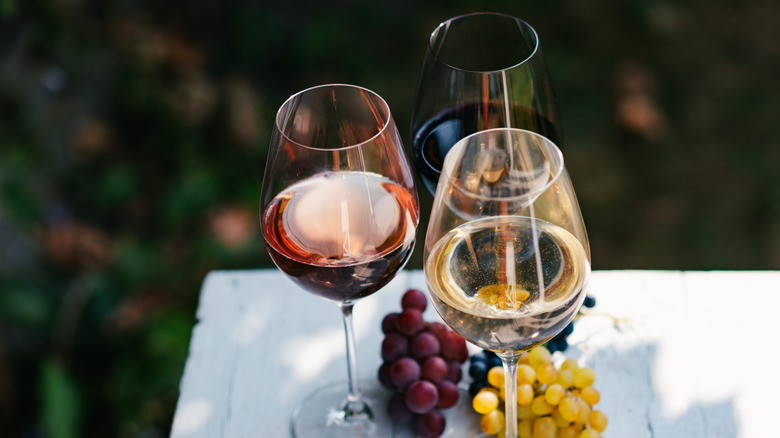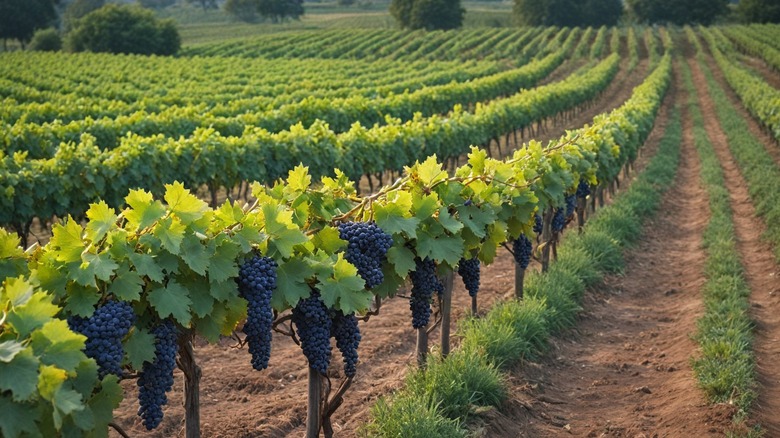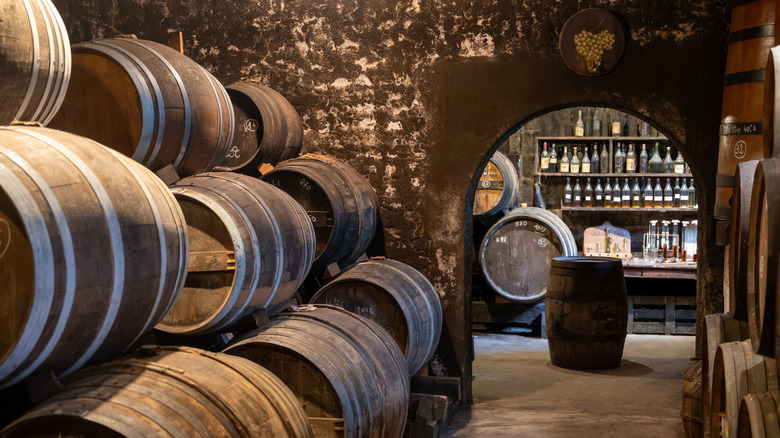Learning About These 3 Wine Aromas Will Up Your Tasting Game
Lounging around at a wine tasting, you'll probably hear a lot of talk about what the wine smells like. The conversations of seasoned tasters will linger on the aroma, their noses deep in a wine glass before it ever touches their lips. The exercise isn't just for show, and it isn't one of those myths about wine — the aroma actually reveals a lot more about the wine's complexity than does taste alone. The tongue can discern five tastes (sweet, salty, sour, bitter, and umami), but the nose can detect a staggering 1 trillion scents. By allowing your sense of smell to have a front-row seat to the oenological occurrence, you'll actually be able to improve your tasting skills. It helps, though, to have some vocabulary to assign to that experience — and there are three aroma types that you ought to know: primary, secondary, and tertiary.
If you've ever listened to experts talk about wine, you've likely heard them discuss specific scents, like roses, strawberries, vanilla, and leather. These are derived from the aroma families, which include floral, fruit, mineral, and herbal aromas. Above them in the taxonomic hierarchy are the three wine aroma types, which have to do with scent profiles developing throughout the wine's lifespan. Understanding the taxonomy and the role of each aroma type within the wine itself will help you look for (well, smell for) the families and specific scents.
Primary aromas are gleaned from the grape itself
Begin with a simple smell of the wine, called the first nose. After the first nose, swirl the wine glass and smell again to get the second nose. Finally, take a taste. After you've mentally absorbed what you've tasted, try to notice what sticks around even after you've swallowed. If you can fully contemplate the olfactory experience at each stage, you'll start to notice different layers of aromas. Some of these aromas start at the roots — these are called primary aromas.
The grape, the vine, the soil, and the climate determine the primary aromas. Although that's still a lot of influencing factors, primary aromas are typically botanical in nature, like honeysuckle and citrus blossom or pear. They may also take on earthy notes, like chalk, or those of herbs and spices, like black pepper. Primary aromas are also often (although not always) shared by wines of the same variety. For example, in sauvignon blanc, you'll frequently find grapefruit and white peach, while merlot will typically present notes like cherry and bay leaf. Familiarity with a wine variety's typical aromas can give you a good starting point for recognizing what notes might be on the nose and for learning how to describe your wine's aroma.
Secondary and tertiary aromas arrive later in wine's life
After the grape is removed from the vine and the vinification process begins, secondary aromas develop. The source of secondary aromas is fermentation and the processes and procedures used in making the wine. Unsurprisingly, these aromas typically depend on yeast, since that's the key ingredient in fermentation — smell for scents like toast and cake. You may also experience some creamy dairy scents, like butter and yogurt, which come from a process called malolactic fermentation that converts malic acid into lactic acid.
Once the winemaking is complete, the aging begins — and tertiary aromas, also called the evolution aromas, materialize. These notes make up what is typically referred to as the bouquet, and they're influenced by the vessel that the wine is aged in, the bottle it calls home, and the amount of oxygen it's getting. This stage may impart earthy aromas or spices, like oak and nutmeg, as well as animal or chemical scents, like leather or chlorine.
Like primary aromas that are often shared among varietals, certain winemaking and aging practices will produce certain secondary and tertiary aromas. For example, vanilla will often appear in wine that's been aged in new oak barrels and mushroom can emerge in red wine that's been sitting in a cellar for a while. If you know any details of the wine's origin or know of commonalities with more familiar wines, you might find some olfactory clues — and feel more informed when you're tasting or shopping for wine.



